#tlaloques
Explore tagged Tumblr posts
Text

Alright who pissed off the rain gods
#aztec mythology#aztec gods#dioses aztecas#nahua posting#aztec#tlaloc#tlaloques#seriously it’s been raining so hard for the past three days#I’ve been on constant flash flood and tornado watches for the past week#some get him to chill
27 notes
·
View notes
Text
Magus Main Character Heights #1
Theo: 155cm / 5 feet 1 inch

Sumomo: 163 cm / 5 feet 4 inches

Alv: 140 cm / 4 feet 7 inches

Aya: 159 cm / 5 feet 3 inches

Ohgga: 161 cm / 5 feet 3 inches

Sophie: 165 cm / 5 feet 5 inches

#theo fumis#sumomo kavishmaf#alv tlaloque#aya guunjoh#dianasys di'ohgga#sophie schwimm#character facts#volume 2#volume 3#volume 4#magus of the library#toshokan no daimajutsushi#manga
16 notes
·
View notes
Text
Tlaloc - Day 143
Race: Genma Alignment: Light-Neutral December 11th, 2024
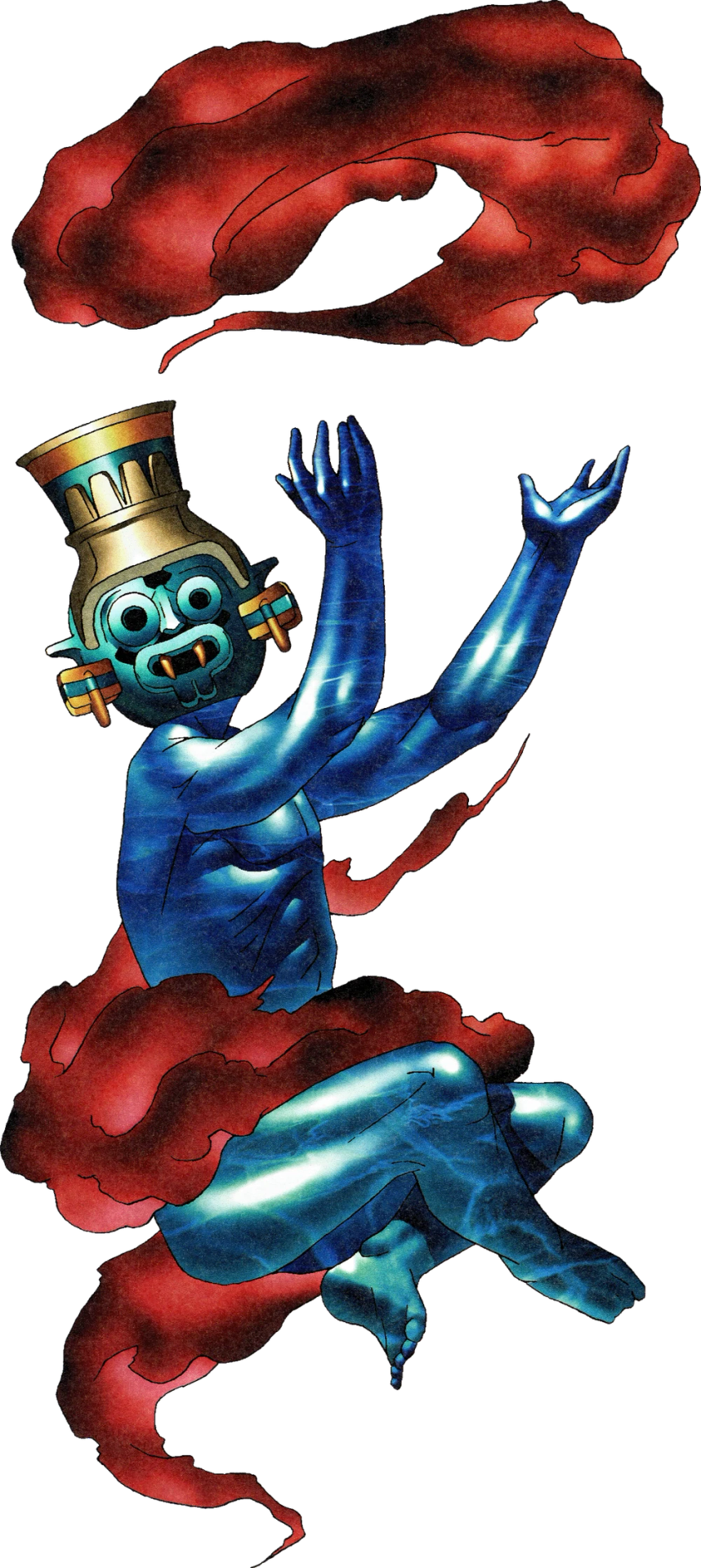
A personal favorite subgenre of demons to me has to be the Soul Hackers/SMT IV designs for Mesoamerican deities. They each have such a unique design that makes them stand out, while still being faithful to the original mythology and also making them stand out as being uniquely Mesoamerican. There's a reason many of these carry over, even into SMT V- they all work incredibly well and establish such a unique vibe. A sleeper pick for a favorite of this bunch, though, has to be Tlaloc- today's Demon of the Day. As with many cultures, the Aztecs, too, had a god of the winds and storms, and, similarly, this one was also incredibly important to the Aztec style of life, so let's dig in to this interesting weather-spinner.
Tlaloc was, while being a god of weather as a whole, more specifically seen as the god of the rain. Predictably, as the Aztecs were situated in Mexico, they revered rain quite a bit- while not very arid and actually rather mild at all times, the importance of growing crops and, specifically, maize- a crop that was incredibly vulnerable to the cold- led to a great importance being ascribed to the rain used to help grow it. This, naturally, also led to the being that brought rain in Aztec cultures being a highly important deity. Tlaloc was seen as an important, if fickle, god, being one of the major gods who stars in the Five Suns myth, and his temple was placed right next to Huitzilopochtli's temple, as they were essentially reflections of the other: while Huitzlipochtli represented the dry season, Tlaloc represented pouring rains.
On that 'fickle' note, however, Tlaloc wasn't just a god of small drizzles- he encompassed everything rain-related, including terrible storms, and he was also important in another light- he was the lord of one of the afterlifes of Aztec mythology as well. Specifically, his afterlife was the place where those who died of illness or the torrential downpours he could bring would go, called Tlalocan. It was a place of bustling plant life and, of course, plenty of maize, and it seemed to be a slight respite after death for those who died in horrifying ways. Also being a god of fertility on top of all of that, Tlaloc was, in some respects, the chief deity of the Aztec pantheon, as his role was that important- crops were vital to many ancient societies for rather obvious reasons, and the Aztecs were no exception. There's a reason that Neolithic societies sprouted around water sources- the ability to grow and harvest food was what essentially led us to our modern day society. Even after the ransacking of the Aztecs by the Conquistadors, belief in Tlaloc was held onto in many areas in Mexico and he can still be seen being venerated to this day.
Curiously, like many Aztec gods, Tlaloc wasn't a single figure- rather, he was split into many, with these other Tlaloc's, named Tlaloque, being spirits supervised over by him and his wife. He and his wife, Chalchiuhtlicue, lived together and supervised these Tlaloque spirits, each of which controlled different aspects of the weather. According to @aztecamemoria's post on Tlaloc's vessels, a set of vessels would be used to simulate rain from Tlaloc, as his face was inscribed onto them. These were also, likely, used to venerate Tlaloc as well, as the way that rain would be brought to people also seemed to be tied to pots: The Tlaloque would literally pour rain down from a jug that likely bared Tlaloc's likeness and would cause thunder by clashing their jugs of water together.
Overall, Tlaloc was a very popular and powerful deity to the Aztec way of life, and is ascribed as chief deity for good reason; his importance cannot go understated due to how his power was what kept the Aztec civilization alive for so long. While fickle, and while he could bring rainstorms to break apart the Aztec society, Tlaloc was ultimately the bringer of gifts that kept the society going. In SMT, Tlaloc's design takes a lot of cues from the Tlaloc pots mentioned earlier- his head literally is one of those pots, while his body is made up of flowing water and he's surrounded by clouds. I honestly love it, especially the pot part of the design, as it ties in so well with his mythology and his role in being the lord of the weather, and I wish I could've seen it in 3D. Still, it's a rock solid design for a god that turns rocks into dust. Does that erosion joke work? Whatever.
12 notes
·
View notes
Text


Tlaloc, Aztec rain god. To the Aztecs of Mexico, Tlaloc was a god of rain and fertility and water. He appeared to them as a man with circles around his eyes and fangs like the teeth of a jaguar. People imagined that he had the power of lightning and thunder and the power to control the abundance of plants and trees and all green things. Tlaloc Images The image of Tlaloc is one of the most often represented and easily recognizable in Aztec mythology, and similar to rain gods in other Mesoamerican cultures. He has large goggled eyes whose contours are made of two serpents which meet at the center of his face to form his nose. He also has large fangs hanging from his mouth and a protuberant upper lip. He is often surrounded by raindrops and by his assistants, the Tlaloques.
Image: Aztec God of Rain by Mahaboka
10 notes
·
View notes
Text

La próxima vez que un mamerto se queje de la conquista de los españoles y el cristianismo cuéntale que los aztecas tenían 18 festividades cada año, una por cada mes azteca. Aquí la lista de los meses y el tipo de ritual que se celebraba en honor a la deidad asociada.
- 1º mes Atlacahualo en honor a Tláloc
⇨ Sacrificio de niños y cautivos a las deidades del agua
- 2º mes Tlacaxipehualiztli en honor a Xipe Tótec
⇨ Sacrificio de los cautivos; luchadores de gladiadores; bailes del sacerdote vistiendo la piel de las víctimas desolladas
- 3º mes Tozoztontli en honor a Coatlicue
⇨ Extracción del corazón de cautivos; enterramiento de las pieles humanas desolladas; sacrificios de niños
- 4º mes Huey tozoztli en honor a Centéotl
⇨ Sacrificio de una virgen; también de un niño y una niña
- 5º mes Toxcatl en honor a Tezcatlipoca,
⇨ Sacrificio de cautivos por extracción del corazón.
- 6º mes Etzalcualiztli en honor a Tlaloque
⇨ Sacrificio por ahogamiento y extracción del corazón
- 7º mes Tecuilhuitontli en honor a Huixtocihuatl
⇨ Sacrificio por extracción del corazón.
- 8º mes Huey Tecuilhuitl en honor a Xilonen
⇨ Sacrificio de una mujer decapitada y extracción de su corazón.
- 9º mes Tlaxochimaco en honor a Huitzilopochtli
⇨ Sacrificio por inanición en una cueva o templo
- 10º mes Xocohuetz en honor Xiuhtecuhtli
⇨ Presentes a los dioses del fuego quemando a las víctimas.
- 11º mes Ochpaniztli en honor a Toci
⇨ Sacrificio de una joven decapitada a Toci; ella era desollada y un joven vestía su piel; sacrificio de cautivos arrojándoles de un lugar alto y extracción del corazón.
- 12º mes Teotleco en honor a Tezcatlipoca
⇨ Sacrificios por fuego; extracción del corazón
- 13º mes Tepeilhuit en honor a Tláloc
⇨ Sacrificios de niños, dos mujeres nobles, extracción del corazón y desollamiento; canibalismo ritual
- 14º mes Quecholli en honor a Mixcóatl
⇨ Sacrificio por aplastamiento, decapitación y extracción del corazón.
- 15º mes Panquetzaliztli en honor a Huitzilopochtli, deidad de la guerra, el sol, el sacrificio humano y el patrón de la ciudad de Tenochtitlan (el más importante de todos los dioses)
⇨ Masivos sacrificios de cautivos y esclavos por extracción del corazón.
- 16º mes Atemoztli en honor a Tláloc
⇨ Sacrificios de niños y esclavos por decapitación.
- 17º mes Tititl en honor a Ilamatecuhtli
⇨ Sacrificio de una mujer por extracción del corazón y decapitación posterior.
- 18º mes Izcalli en honor a Xiuhtecuhtli
⇨ Sacrificios de víctimas que representan a Xiuhtecuhtli y sus mujeres (cada una de 4 años de edad!!!) y sus cautivos
En fin, cada año, los aztecas sacrifican un promedio de 20,000 personas, desde hombres adultos a niños recién nacidos, de diversas y tortuosas maneras. En ocasiones especiales, los "dioses" exigían incluso más sangre de lo habitual. Por ejemplo, cuando se dedicó un nuevo templo a Huitzilopochtli en 1487 (32 años antes que Cortés arribara a la costa mexicana), se estima que 80,000 personas fueron sacrificadas.
===
– Imagen:
El Códice Magliabecchiano, folio 73r, una escena que representa el canibalismo azteca ritualista, una práctica común después de los sacrificios. De hecho, el típico plato mexicano "pozole", antes de la llegada de los Españoles, era preparado con carne humana de los sacrificados. Fue gracias a la influencia Cristiana Española, que el pozole ahora se prepara con carne de cerdo. El códice fue creado durante el siglo XVI en el periodo colonial temprano y muestra los nombres de los 20 días del tonalpohualli, calendario religioso de 18 meses que forma parte del ciclo de 52 años mexica.
10 notes
·
View notes
Text

Vía Chalchiuhtlicue Tlaloque
🔥 Tu verdadero valor se vio cuando,
Aún con el corazón roto,
No buscaste venganza
Ni lastimaste a nadie.
Solo te quedaste ahí,
Tratando de entender y sanar.🔥
7 notes
·
View notes
Text
Tlalocmon a new Digimon based on Tlaloc, Aztec god of rains and water: How does it stand up?
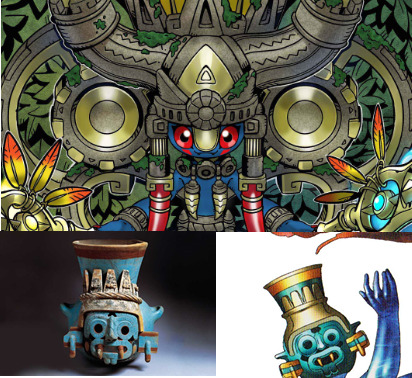
You need very little checking to know that Tlaloc is one of the most important and popular Aztec gods. Presiding over Rain and water, Tlaloc held significance to the lives and beliefs of those who worshiped him.
Recently, the Digimon franchise introduced us to a new monster, due to feature in their newest virtual pet device release. This creature is Tlalocmon, and is based on the same Tlaloc from Aztec mythology. It is not the first time Digimon deals with Mythology, Religion and Folklore. Actually, it is rooted in this franchise's core. And i honestly think they do a way greater job into understanding cultures, depicting and adapting it to their themes, then Megami Tensei, which... Is a discussion y'all are not yet ready for!
But, let's analyze Tlalocmon, and see how it holds up to his non-digital inspiration, here on Earth. As always, sources will be in the end of the post, which is just a crop, really. I encourage you guys to dive in the sources if the topic interests you! I will keep it simple, thought, because this was not meant to be a giant post.
For a very brief introduction Tlaloc (pronounced: Tlá-lok) is a central Mexican deity of waters and storms, that was mainly worshiped by the Aztecs. Although he is much spoken of, and very popular, he was not alone in his tasks, often accompanied by the goddess Chalchiuhtlicue, his current wife. They lived in the underworld called Tlalocan, where they kept the waters of all 4 quarters of our universe. There were other beings residing in Tlalocan, called Tlaloques, that also helped on those tasks. [1] Talk about a healthy and productive work environment!
Mortal souls could go to Tlalocan, according to Aztecs beliefs, if you died from the following causes: Drowning, lightning strike, dropsy, gout, leprosy, scabies, aches and pains, etc... People with certain traits as the physically disabled and with stunted growth would also be destined to meet Tlalocan, once they became a shirt of forever missed.
The author Kay Read, which wrote several books on Aztec Mythology theorizes in her book ''Handbook of Mesoamerican mythology'' that Tlaloc's importance and influence was a result of the Nahua civilizations inhabiting a very hostile and semiarid environment. Which makes a lot of sense. It was also said Tlaloc kept the waters of the universe in giant mountains, like pots. When the time came, Tlaloc would release these waters upon the Earth. [1]
Still according to Read [1] Tlaloc image remained very consistent as years came by. The key features were his ''goggled eyes''', fangs in his mouth were its key features. Some times it was depicted in pottery with lightning. Tlaloc had a temple mayor in the Aztec Capital of Tenochtitlan, which showed his importance. Tlaloc also was related to summer solstice, wet agricultural season. [3]
Tlaloc was born, according to the Nahua/Aztec, created by Huitzilopochtli and Quetzalcoatl. His wife was also created by the duo, the after mentioned: Chalchiuhtlicue. (Although he was once married to Xochiquetzal, she was stolen by Tezcatlipoca, ending their union.) Tlaloc name could be translated as something as ''Inside the Earth'' [1]. Just before the rainy season, Nahua took part in Human sacrifices at Mount Tlaloc, t nourish Tlaloc and his peers to have the strength to break the pots of the waters in our universe. [3]
Another very important feat of the God, according to Aztec mythology is that Tlaloc consumed one of the four suns, raining down into this age. If the current fifth age would like to be continued, the Aztec should keep the god well nourished. [1] Also according to myths [1] Tlaloc helped the Mexica to defeat the Toltecs, previous people in power, bringing fresh rains to the Mexica while starving the Toltecs in droughts. So important was Tlaloc, that when the invaders from Spain arrived, Motecuhzoma II made a gift of a garb of Tlaloc to give it to Cortés. Cortés, being the stupid asshole he was, of course did not liked it. [1]
Tlaloc was also associated to jaguars [1], [3]. He would be often depicted with it, or wearing something resembling a jaguar. There is also evidence that Tlaloc was being worshiped in Central America even before the Aztecs were present. [3]


At first glance, Tlalocmon matches this profile quite well! I love the artistic freedom the designer had, by converting its eyes from the goggled ones, to the characteristic Digimon eyes, that artist Kenji Watanabe popularized by his designs. It also has the notorious fangs of the non-digital counterpart. The blue color of the skin is another trait correctly borrowed from our world's Tlaloc, while not all of his depictions were blue, most of the surviving artifacts we have are in fact colored blueish. You can see it from pottery, to illustrations and other works of art from the Mexica. [1], [3]
Where the designer really went crazy is Tlalocmon's fit. First, the entirety of the Digimon ''Armor'' seems to be made of stone, and almost (or should i say, tries a lot to) share some architectonic resemblances to Aztec style. I say ''resemblances'' because it is mostly, generic architect gibberish. Not to say they did not try to stay true to their sources, the sides of the helm seems to be two columns that, although share some greco-roman traits, are trying to emulate Mexica architecture. I searched some books, and articles about Aztec architecture, and i could not find any matches to what they were trying to portray [2], while i had seen it in more generic drawn Aztech constructions. But this does not mean Tlalocmon's armor is lame, actually you will see soon enough it shines pretty bright under the certain lights...
The entirety of its armor, and plates is depicted with moss and plants growing over, and it seems dilapidated. Maybe trying to portray the abandoned ruins of temples in Mesoamerica. Personally, i am not a big fan of it, because it suffers from a problem that usually media depicting the Mesoamerican cultures have: Their culture, lives and construction were full of color! You can see it even by the Spanish Invaders illustrations. The dilapidated aesthetic associated with those cultures are a relatively new movement. You can easily trace it back to the early 20th century, when the ruins of those civilizations were being re-discovered, already in a decadent state, after centuries of abandonment. That, however was not their real state. But i will consider that Digimon usually tries to amalgamate pop culture into its designs, so we let this pass.


The feathers in his helmet are a directly reference to illustrations of Tlaloc, even the colors are very close. These same feathers are repeated through the design, which are also accurate as far as my research goes. The horns are something the designers got a bit of freedom with, since there's almost no evidence of horns in any Tlaloc imagery i could find, except of course for this one.
The lush greens growing out of Tlalocmon can be 3 things: First, a necessary nod to its product, Tlalocmon is being marketed as a new Digimon of the ''Nature Spirits'' archetype, so its design needs to have nature inspired themes. It also can be related to the ''old ruins'' aesthetic, but i believe it fits well with Tlaloc relationship with wet agricultural seasons, and plants thriving under wet climates. Maybe a mix of all of the above? Most notable, Tlaloc was known by having a cape as a feature,[3] which can be kinda of seen by the plants growing in the back of Tlalocmon, when seen from afar they instantly looks like a cape.
Tlalocmon's main body structure is a bit childish and small in stature. Those features were associated with this deity as well, it often requiring children sacrifices [3], [4]. Also the Tlaloque from Tlalocan, and even Tlaloc itself were often depicted as small in stature! [3], [4] I personally like the childish appearance of this design, because of that.
But for me the real genius of Tlalocmon helmet and armor, can only be seen when you remove a bit of detail, and the own Digimon from the picture. Using my poor Photoshop skills, i ilustrated how Tlalocmon's helmet is in fact... The real Tlaloc's head! Or at least, is referencing it:

This is simply genius!
The blue color of Tlalocmon is also referencing the constant imagery Tlaloc had. Of course, he was not always blue, but most of the time it was depicted as such. [3]
The last bit of the design i would like to comment is the staffs Tlalocmon holds. They are clear nods to the origin of this Digital Monster, this being Tlaloc domains: Water, storms, and lightnings. There is duality here: The rain that gives life to the land, but also can destroy it with storms. This was also associated to Tlaloc. Remember he destroyed one of the last eras?
At first, i did not think much of those staffs, but diving into the sources that 'Arqueo e Espírito' sent me, it suddenly clicked to me that they are referencing Aztec digging sticks, a type of tool the Aztec used to sowed the crops! This is another genius touch to this design, because not only Tlaloc was associated with this tool [3], [4] but also with crops growth. Having it as the main weapons of this Digimon, wielding both water and lightining are an amazing touch. Of course, it was heavily stylized to match the franchise. But it still there!

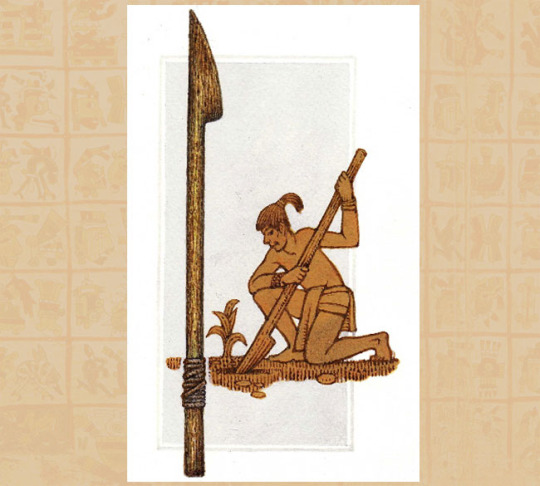

Tlalocmon's dig stick seems not too usable to sow the crops, but at least is a cool magic staff...of sorts (?) There's also no instances i could find of those sticks being ornamented with feathers, but still...
And those were my thoughts on Tlalocmon's design. This Digital Monster was brought to my attention by good friend, @atmaflare. As he guessed, i really liked the design. They took some liberties with it, but Digimon aesthetic often needs this treatment, as for the reasons i already stated.
As i said before, Digimon is a franchise that makes good points on Folklore, Mythology and Religion. Many of their medias are centered around it, such as the last game released: Digimon Survive. For me it was kinda refreshing to see a take in Tlaloc that does not involve pottery of any sorts, but still tries to remain faithful to the source material. The designer clearly did their homework here!
I wait to see Tlalocmon's official profile when it releases with the product it is advertised for, the Pendulum Color Virtual pet. I can only hope he dwells in caves and mountains through the vast plains of the Digital World!
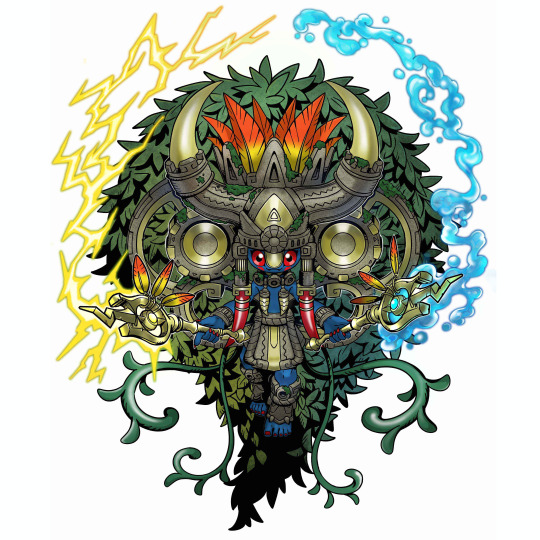
Please, note that i am not a Mesoamerica specialist. That was not my exact area of study, but i do research mythology in general as a part of my Religious Sciences degree's curriculum. So, if you notice any mistake or misinterpretation of my part, please reach me and i will absolutely correct it given the soures and context! And yeah, i plan to take some classes and courses on Mesoamerican culture soon enough, there is so much stuff to study about it!
Sources:
-1: 'Handbook of Mesoamerican mythology' - Key Read
-2: 'StudiesinAncient Mesoamerican Art andArchitecture Selected Works byKarlAndreas Taube'
-3 https://www.mexicolore.co.uk/acrobats/319_1.pdf (This amazing article was sent to me by the great ''Arqueo e Espírito'' They study mesoamerican culture and publish about it on the internet, and are to this date one of the best sites on my country about the matter! This material has other good sources, since im doing just a crop, i highly encourage you to deep dive into it.
4- Mexicolore: Studying the Digging Stick

Hey, Tlalocmon's sprite is so cute... oh and if you like Tlaloc, why not remember that time when Taylor swift fans offered him friendship bracelets, so the rain wouldnt ruin their event, lol.
#Tlaloc#aztec mythology#digimon#character analysis#mythology#blazescompendium#virtual pet#digital monsters
24 notes
·
View notes
Text
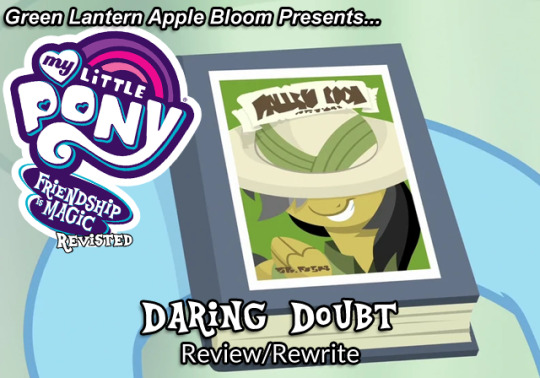
History is written by the winners.

The episode that changes everything and our final Daring Do Episode of the series. It begins with Fluttershy getting into the Daring Do series now. She’s even a fan of this new book that Rainbow Dash didn’t know about. That’s because it's a completely different author. And the Author is trashing Daring Do by making big lies surrounded by smaller truths to make Dr. Caballeron look better. And it’s working.
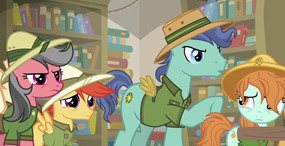
At the A.K. Yearling signings, these fans are basically attacking her. Sadly similar to how some pony fans attack G5 fans and actors. It's really sad when fiction is reality. And continuing that train of thought, the Author of the Pro-Caballeron books is Dr. Caballeron himself under a disguise. After confronting him, Caballeron tries to tell his side of the story but Dash refuses to listen. Fluttershy on the other hand does.

Now to be fair, Fluttershy never actually interacted with Caballeron on the show like Dash has. The closest she has to actually meeting the guy was in Daring Don’t. And all she did was watch the action like it was a stage play. It was only her that snapped everyone out of it to actually have the story continue. The only other Main Pony who actually interacted with Caballeron was Pinkie Pie. So Fluttershy taking the time to listen and hear his side of the story is believable. Though we all know he’s tricking her to join his expedition.

Dash decides to go to Daring Do to inform her about this and Daring Do knows his plan: he’s after the Truth Talisman of Tonatiuh since it's made of Pure Gold and only the Wings of a Pegasus can get it. So he plans on using Fluttershy to get the Talisman and take whatever trap associated with it. And it is a very dangerous trek even with a map, which is why Daring Do never went to get it herself.
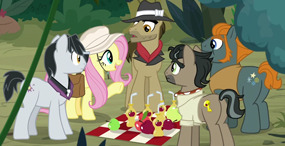
Thing is, this isn’t Flutttershy’s first rodeo. So while they were thinking of just manipulating her and ditching her when things go South, Fluttershy’s nature wins them over to the point that they’re willing to risk their own lives to save her. Give her Tirek or Cozy Glow, they would have fallen under her spell of kindness. Chrysalis is a lost cause. So when the two sides got together, thanks to the Truth Talisman, Caballeron admitted he only wanted to get it for the money but valued Fluttershy’s friendship.
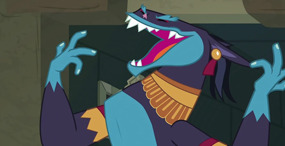
Then Ahuizotl makes his second actual appearance in the series. Yeah, besides fantasies and Daring Do’s book, Ahuizotl only made a real appearance twice in the show proper. He once again wants them to stop taking his artifacts. After a chase, Fluttershy decided “you know, why don’t we listen to him and find out why he’s doing all this.” And using the Truth Talisman, Ahuizotl reveals he is the guardian of these lands and he’s been trying and failing to stop these guys from taking the artifacts.
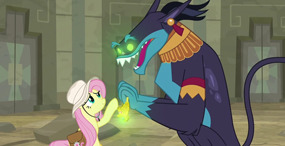
Now I know a lot of people don’t like this twist. Thing is, we really only had one account of Ahuizotl prior to this episode. Every other instance was from Daring Do’s point of view. Now something I haven’t done was look at the actual mythology of the Ahuizotl to see if that was a hint of this twist. Apparently it is an aquatic creature who lure victims near water to drown them. But here is an excerpt that I found that may have shown this twist was possible.
According to Aztec religious belief, those who met their death by drowning travelled to the beautiful earthly paradise of Tlalocan, home to the water god Tlaloc, his wife, Chalchiuhtlicue, and their helpers, the Tlaloque. It was thought that they were chosen for this fate by these deities either because of their goodness in life should be rewarded by an eternity in Tlalocan, or because they had dared to hoard precious stones, symbols of water, instead of offering them to the gods
And what does Ahuizotl say?
If another artifact goes missing on my watch, I'm going to be in so much trouble with the other guardian creatures.
Could the other guardian creatures be the Tlaloque? Either way, mythology suggests he does have bosses and one of his reasons for killing is because people are hoarding precious stones. And some stones could be considered relics. So it is entirely possible that this was always the plan. But I digress. After hearing this, using the Truth Talisman to ensure they are telling the truth, both Daring Do and Caballeron promise to stop stealing artifacts from him.

The episode ends with the Authors teaming up but they get overshadowed by Ahuizotl who released his own book. I honestly like him with glasses. Overall, I enjoyed this episode. Fluttershy showing off she could probably with 90% of villains over and giving a nice conclusion to the Daring Do storyline. And I don’t mind the twist of Ahuizotl being a guardian. Gives me joke ideas. Click here to see the original review and how it fits in GLAB’s Canon.
2 notes
·
View notes
Text
COINCIDENCE? Newly acquired Planned Parenthood building looks like Aztec child sacrifice pyramid for the “blood-thirsty” Satanic deity Tlaloque
https://antichrist.news/2023-08-06-planned-parenthood-building-looks-exactly-like-aztec-child-sacrifice-pyramid-for-the-blood-thirsty-satanic-deity-tlaloque.html
View On WordPress
7 notes
·
View notes
Text
So I've been trying to find information on my ancestors' prehispanic practices (easier said than done) and —
Did you know there's apparently no evidence of Chalchiuhtlicue being worshiped in what is now la Ribera de Chapala? Tlaloc was/is a popular deity. There's plenty of evidence of his worship. There's even a surviving local myth about him. But Chalchiuhtlicue appears to be missing. Same with the Tlaloque. He does, however, have a daughter. You will not find any mention of this daughter in Aztec mythology. She isn't Aztec
2 notes
·
View notes
Text
¿Quiénes somos?
Somos una empresa dedicada transformar los hogares con el fin de promover la economía circular, buscando la maximización de los recursos con el mínimo de residuos, pues somos conscientes de lo complejos que se han vuelto los problemas en cuanto a la obtención de agua en momentos de sequía y con base en las temporadas, el estilo de vida y la casa logramos adecuar sistemas que con el tiempo darán valor agregado a nuestra calidad de vida.
Misión
Somos una empresa dedicada a promover una vida sostenible mediante propuestas sustentables, aplicando un concepto de economía circular en la gestión de los recursos y los residuos, al maximizar los recursos y minimizar los residuos a través de una experiencia personalizada para todos los hogares.
Visión
Buscamos generar una comunidad sustentable mediante una revolución socioambiental de las conciencias con el objetivo de la preservación de los recursos naturales cuidando el medio ambiente, con el fin garantizar a largo plazo el acceso equitativo e igualitario a este derecho para que al aplicarlo en colectividad transicionemos a ciudades sostenibles, manteniendo un enfoque congruente con los Objetivos de Desarrollo Sostenible 2,3,6,7,9,11,12,13,15,17 de la agenda 2030 de la ONU.
Filosofía
En Tlaloques, proporcionamos soluciones a las problemáticas socioambientales promoviendo la sostenibilidad mediante la sustentabilidad de los recursos, garantizando lo más indispensable desde el enfoque taxonómico de “Maslow”, la innovación y la responsabilidad social. Creemos firmemente en la importancia de preservar los recursos naturales para las generaciones futuras y la preservación del medio para tener una salud integral y ecológica, con el enfoque de “una sola salud” (OMS y FAO, 2000) y una perspectiva transdisciplinaria. Destacamos la importancia de facilitar el acceso a ecotecnias con el fin de cimentar y promover una cultura en la maximización de los recursos y minimización de los residuos, transformando los residuos en recursos con valor agregado. La responsabilidad social nos guía a actuar de manera ética y equitativa, asegurando nuestro compromiso con la comunidad.
HISTORIA
Tlaloques nació de una conversación inspiradora entre estudiantes del área de la salud, que se unieron para apoyar la idea de Jesús, un joven preocupado por la crisis hídrica en el Valle de México. Jesús Pérez Ortega, proveniente de una ciudad caracterizada por la unidad, el amor y el servicio, decidió que era momento de actuar para enfrentar la creciente escasez de agua, con un enfoque de una sola salud de la OMS. Armado con una profunda fe en la comunidad y un amor genuino por su entorno, Jesús se inscribió en una convocatoria para presentar una propuesta que ayudara a abordar esta problemática.
La propuesta de Jesús se convirtió en una oportunidad cuando fue seleccionado para participar en un programa de capacitación integral. Este curso, respaldado por figuras destacadas como el presidente, la Secretaría de Energía, la Comisión Federal de Electricidad y las secretarías de Trabajo y Previsión Social, así como de Educación Pública, tenía como objetivo formar a individuos en temas cruciales como la historia natural y cultural del territorio, la valoración de la riqueza natural de México, la importancia del agua para la vida, la conservación de flora y fauna, y la producción orgánica sustentable, entre otros.
El curso se llevó a cabo en la escuela Muros de Agua “José Revueltas”, un nuevo símbolo de recuperación y restauración post-crisis, que también funcionaba como modelo carcelario del siglo XXI y promovía la formación de Guardianes del Territorio. Este apoyo institucional sólido brindó a Jesús y su equipo una base firme para expandir su visión.
Impulsados por el éxito de su propuesta y el apoyo recibido, Jesús y sus compañeros fundaron Tlaloques. La empresa se estableció con el propósito de extender los beneficios del curso a la comunidad en general, facilitando una vida más sustentable. Tlaloques se enfocó en fomentar un tejido social fuerte y en promover una ciudad sostenible, enfatizando la importancia de aplicar el concepto de economía circular. Esto significa maximizar el uso de los recursos mientras se minimizan los residuos, un enfoque que Tlaloques integró en todos sus proyectos.
Hoy en día, Tlaloques se destaca como un referente en la promoción de prácticas sustentables y en la educación ambiental, contribuyendo a la creación de comunidades más resilientes y un futuro más verde para el Valle de México

0 notes
Text










Don’t buy Aztec Myths by Jake Jackson there’s a bunch of blatant mistranslations and misinformation
This is just for the gods. There’s also like culture misinformation and it’s just bad
#aztec mythology#aztec gods#dioses aztecas#nahua posting#tezcatlipoca#quetzalcoatl#tlaloc#tlaloques#nanahuatzin#metzli#I hate “evil Tezcatlipoca#it’s so annoying
26 notes
·
View notes
Text

Some artwork skipped over between volume 2 and 3's covers. Other than the front-facing future trainees, if one looks closely, one can also spot Chise Redd (administrator of the writing portion of the kafna exam in chapter 9), that one lady who is supposedly titillated by stressed-out children, and the spirit within the latter's grimoire.
Izumi-san's comment: "The point where volume 2 and 3 meet. Connecting covers nicely in print is always a hard time 😥" [webmaster's translation]
#mihona qoahau#sala sei sohn#alv tlaloque#aya guunjoh#cover art#volume 2#volume 3#magus of the library#toshokan no daimajutsushi#manga
2 notes
·
View notes
Text
Period of The fresh Gods God Away from Storms dos Slot Remark
Blogs Praise Of Poseidon Geographic Setting Age of The newest Gods To the web page twenty eight of the Codex Borgia, the 5 Tlaloque is envisioned watering maize fields. Per Tláloc is actually pictured watering the newest maize with differing types away from rains, at which only one try beneficial. Continue reading Period of The fresh Gods God Away from Storms dos Slot Remark

View On WordPress
0 notes
Text
¡Combo de #tlaloques de colores y sabores! 🤎💗💛💙🤍
No importa dónde, estos curiosos artefactos captadores 🌧️ se adaptan a cualquier contexto, cual camaleón 🦎.
#CaptaLaLluvia





Quiero uno ROSAAAAAAA
0 notes
Text

Últimamente ha llovido por dónde vivo y pues debo mostrar mi agradecimiento a tlaloc uwu 💙
19 notes
·
View notes